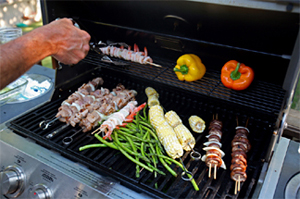 Summer means grilling in the backyard. It is the oldest and most universal cooking method. And, it can require a lot of elaborate equipment and grilling accessories.
Summer means grilling in the backyard. It is the oldest and most universal cooking method. And, it can require a lot of elaborate equipment and grilling accessories.
But, you only need 5 basic tools to accomplish pretty much anything on the grill. But, there are some specialized gadgets that can help you make grilling a lot more exciting. Here are some of both.
The Essentials:
1. Chimney starter
If you're really serious about grilling, you'll want to cook over charcoal. It burns hotter and drier than propane, producing a better char and a more savory crust. Plus, it's easy to smoke on a charcoal grill but it's virtually impossible to do so over gas. The best way to light charcoal is in a chimney starter, which ignites the coals quickly (in 15 to 20 minutes) and evenly (with no unlit coals on the periphery) without requiring lighter fluid, which can leave a petroleum taste. Remember that natural lump charcoal gives you a cleaner burn than briquettes.
2. Grill hoe
Unlike gas grills, charcoal grills have no burner knobs; one of the best ways to control the heat is by building your fire smartly. For direct grilling, I recommend a three-zone fire: a thick layer of coals at the back of the grill to give you a high heat for searing; a thinner layer in the center of the grill to give you a moderate heat for cooking; and no coals in the front to create a "safety" zone (an ember-free area where you can move food to dodge flare-ups).
Tip: Make sure the hoe handle is wood — burning plastic doesn't smell all that terrific.
3. Grill brush
You have probably heard the grill master's mantra: "Keep it hot. Keep it clean. Keep it lubricated." That is: Start with a hot fire. Brush your grill grate clean with a stiff wire brush. And oil it with a tightly folded paper towel dipped in oil and drawn across the bars of the grate with a pair of tongs. (This last step also mops up the rare stray brush bristle.)
We like a brush with steel bristles on one side (for cast iron and stainless steel grates) and brass bristles on the other side (for more delicate surfaces, like porcelainized enamel grates). A long handle helps, too, to keep you away from the heat.
4. Long-handled, spring-loaded tongs
Another grill mantra is "Turn, don't stab," meaning that it's better to turn steaks, chops, and even burgers with tongs than to stab them with a barbecue fork, which punctures the meat.
Look for sturdy, spring-loaded tongs with rolled or reinforced steel arms (so they don't buckle when you go to pick up a whole chicken or pork shoulder) that is at least 16-inches long (to keep your hands away from the fire).
5. Instant-read meat thermometer:
There's only one reliable way to tell meat is properly cooked, and that's to check its internal temperature using an instant-read thermometer. One with a needle-thin probe for easy insertionand a digital readout that indicates the precise temperature to the degree. Tip: When checking the doneness of a steak or burger, insert the thermometer probe through the side, not the top — you'll get a more accurate reading.
The Not-So-Essentials:
6. Grill basket
Even if your grill has a grate, a grill basket can help you grill fragile fish or vegetables (like sole or tomatoes), or small pieces of food that might otherwise be hard to handle (like shrimp or okra).
Grill baskets come in myriad sizes and shapes — some are specialized for particular foods, like whole trout (fish baskets) or miniature burgers (slider baskets). Whichever one you pick, the beauty of a grill basket is that you turn it, not the food. Just remember to oil the basket with a folded paper towel dipped in oil — or spray oil on it — before adding the food.
7. Suede grill gloves or welder's gloves
Grilling requires handling lots of hot objects — from lit chimney starters to hot grill grates. To protect your hands, you want heavy leather or suede gloves — preferably with long sleeves to shield your forearms from the sparks and heat.
You can find all of these grilling tools and more at West Sport in Sudbury, contact us.
theweek.com

Comments
{tag_commentlist}